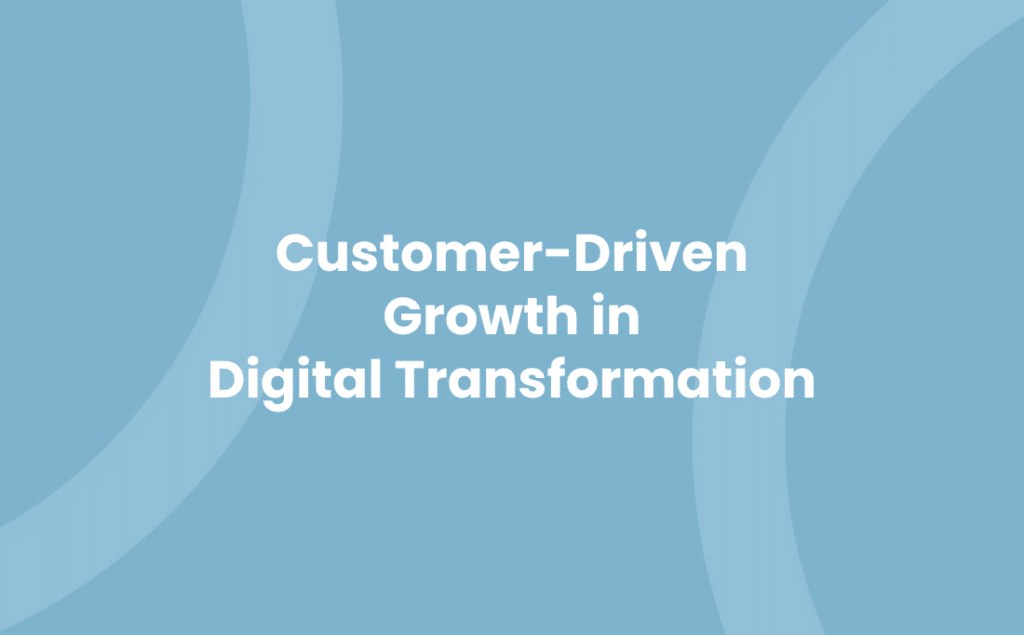In the fast-paced world of technology, digital transformation isn’t just a buzzword – it’s a crucial pivot for businesses wanting to stay relevant. But where do customer insights fit into this digital jigsaw puzzle?
As you delve into this article, you’ll discover the powerful synergy between digital transformation and customer insights. We’ll explore how understanding your customers’ needs can fuel your digital strategies, driving your business forward in this increasingly digital age.
So, whether you’re a tech guru or a digital novice, let’s dive into the world of digital transformation and see how customer insights can take your business to the next level.
Understanding Digital Transformation
Roughly put, comprehending digital transformation involves recognising the shift from manual and traditional methods of operation to digital and automated ones. This paradigm shift calls for a complete overhaul of existing business activities, processes and models, ideally, backed by technology advancement, aiming for increased efficiency and competitive advantage.
Digital transformation is not just an IT initiative; instead, it’s a business-wide movement, affecting every aspect of a firm’s operation. It’s an opportunity for companies of all sizes, in all sectors, to leverage technology and data to achieve organisational objectives, identify market trends, and even predict future customer behaviour.
Let’s break down digital transformation into three core areas, namely: technology change, organisational change, and cultural change.
- Technology Change: This involves implementing highly advanced digital solutions such as artificial intelligence (AI), cloud computing, IoT devices, and big data. It improves workflow, encourages innovation, and helps businesses stay current in a digitally-fueled economy.
- Organisational Change: A successful digital transformation means pivoting the entire business structure out from the traditional, into the digital. This pivot extends to talent acquisition, training, and even reward structures, often requiring a fresh approach to leadership.
- Cultural Change: Digital transformation is not just about investing in the latest tech-tools but encompassing a culture that welcomes continuous learning, flexibility, transparency, and collaboration.
The successful digital transformation journey involves identifying customer needs, and positioning digital strategies, such as the application of customer insights digital strategy, towards improved experiences. In the digitally transformed world, businesses that harness digital transformation customer insights can better anticipate client needs and refine their product offerings.
Three key ingredients to foster digital transformation are continuous learning, data-driven decision making and agility. It’s crucial to keep up with the latest technologies, understand the potential impact and be swift to adapt. Remember, transformation doesn’t happen overnight. But with patience and persistence, you can harness the power of digital and propel your business into the future. Remember, it’s not just about the transformation but how you transform that determines your success.
Unfolding Customer Insights
Unlocking the potential of customer insights propels your business into the realm of excellence in digital transformation. But, to truly leverage customer insights, you must first understand them.
Deeper customer understanding encompasses acknowledging not just what your customers want, but why they want it. Dig into the psyche of your clients, respect their individual journeys, and illuminate the paths they tread on your digital platforms.
Next, adopt an analytical approach. Harness your data and lean towards state-of-the-art technologies to convert raw snippets into meaningful interpretations. For instance, AI and machine learning hold exceptional potential for the analysis of large data sets. They analyse and single out patterns in customer behaviour providing priceless information for your digital strategy.
Moreover, feedback plays an instrumental role in fine-tuning insights. Resist the inclination to gloss over unpleasant observations. Welcome negative reviews, value them as a window to betterment. It’s not merely about establishing a digital setup but also fostering a digital mindset, where feedback fuels growth.
In the world of digital transformation, it’s crucial to sustain agility. Trends fluctuate, tastes evolve, technology advances at an unrestricted pace. Stay on top of these shifts and mould your strategies accordingly. Flexible digital tactics not only cater to your current customer base but also attract potential clientele effectively.
Finally, strive to create a continuous learning culture. Equip your team with essential tools, train them to delve deep into the ocean of data, and hone their analytical skills. As a result, you’ll witness your digital strategy evolving, inching you closer to unerring predictions of customer behaviour.
Enhancing customer insights does not solely rest on technology change, but also necessitates organisational and cultural shifts. Hence, it’s of utmost importance to cultivate a data-driven culture, embrace speed, adapt to alterations, and welcome feedback. This can lead to unlocking the secrets of your customer insights and consequentially supplementing your digital transformation journey.
Bridging Digital Transformation and Customer Insights
Crafting digital strategies hinges on a deep understanding of customer insights. When unveiling these insights, you explore the motivations that drive your customers’ behaviour. Data analysis technologies, such as artificial intelligence (AI) and machine learning, further assist in deciphering raw data into actionable insights.
Take it a step further by appreciating the value of customer feedback. Implementing this critical input into your digital strategy is a proactive approach towards improvement. Moreover, maintaining agility allows you to keep pace with consumer trends, ensuring your digital transformation stays relevant. Encourage a culture of constant learning within your business; it’s the driving force behind the advancement of digital transformation strategies.
Indeed, digital transformation hinges on more than technological change. Organisation and cultural shifts possess an equally significant part to play. Businesses integrating customer insights into their digital strategies witness their performance improve exponentially.
Moreover, with digital transformation, you’re not merely navigating techno-organisational changes. You’re delving head-first into a world of customer insights, illuminating the means to further enhance your strategies.
In the process, you’re not only unlocking secrets that drive customer motivation but you’re also equipped with formidable data analysis tools to draw from volumes of raw data. The feedback you receive from it doesn’t just sit in silos; it permeates throughout the organisation.
At every point, the focus needs to shift to learning and adapting, keeping in step with ever-changing customer behaviours. You need to remember; digital transformation is not an end in itself. It’s a journey, and one that shouldn’t be a blind race.
Overall, bridging digital transformation with customer insights isn’t a bespoke solution; it’s a necessary strategy for bolstering business growth. When you show your customers you’re listening to their needs and tailoring solutions to meet their expectations, your digital transformation journey will be a success story worth telling. Remember, the practices you uphold and the culture you adopt throughout the process will define your organisation’s transition into the digital era.
Case Studies: Successful Digital Transformation and Customer Insight Usage
Delving into practical applications, let’s gaze at a couple of case studies that illustrate the efficient utilisation of customer insights in the realm of digital transformation. These businesses, understanding the pivotal role customer insights play, carved out digital strategies infused with actionable intelligence from customers, hence driving enhanced performance and business growth.
Starbucks – Championing the use of AI and machine learning
Starbucks showcases one example wherein data analysis technologies are employed to fine-tune customer experiences. Leveraging artificial intelligence and machine learning, Starbucks introduced the ‘Deep Brew’ system. This technology supports decision making, simplifying inventory management and workforce scheduling. But the real catch, the Deep Brew system, is built to learn about customer preferences, suggesting product recommendations. The implementation of this technology is a testament to the brand’s focus on using digital transformation customer insights to drive business performance and growth.
Dominos – Embracing digital transformation
Dominos, let’s say, has cooked up quite a success story. The company, on the brink of bankruptcy, embraced digital transformation and made a commendable comeback. It pivoted its business model, shifting from brick-and-mortar to digital-first. But note, accepting digitalisation wasn’t the catch-all solution. The company leveraged customer insights digital strategy, tailoring its services according to customer preferences. Customers saw a wave of innovations like mobile ordering, real-time pizza tracking, and multiple ordering methods. These transformations, initiated by insights, led to Dominos dominating the pizza delivery market.
To recap, both companies understood the driving force behind successful digital transformations is not merely the use of advanced technology. It’s about the integration of customer insights into the heart of their digital strategy. The ability to unlock secrets from customer motivation and behaviour data led to effective digital transformation. This approach is instrumental when it comes to businesses stepping toe-to-toe with the ever-evolving world of digitalisation.
Challenges and Solutions in Digital Transformation and Customer Insights
Embarking on a journey of digital transformation whilst leveraging customer insights poses several challenges. Recognising these obstacles and implementing appropriate solutions is paramount for business progression and success.
Imminent challenges often include data overload, analytical capabilities, technological integration, and the resistance to change within the organisation. Data overload stems from an abundance of customer information which can render you incapable of identifying significant insights. Remedying this, however, is made possible through the use of advanced technologies such as Artificial Intelligence and Machine Learning. These establish a systematic structure for collecting and analysing substantial amounts of data, thus ensuring meaningful customer insights are readily available.
Analytical capabilities pose another predicament as businesses often struggle to extract useful information from raw data, negatively impacting their digital transformation strategy. This is where Data Scientists are integral. Specialists in their field, they possess the know-how to interpret complex data, providing simplified customer insights that can be woven into your digital strategy.
Technological integration difficulties often arise when businesses attempt to embed new technologies into existing systems. This process can be streamlined by early adoption of emerging technologies and keeping pace with digital trends. By doing so, businesses remain technologically progressive and are better equipped for the digital challenges ahead.
Implicitly, resistance to change is common in many organisations and is invariably a stumbling block in the pathway to successful digital transformation. Tackling such resistance requires cultivating a forward-thinking culture within the organisation. This means continually educating employees about the benefits and necessity of a digitally enabled workspace, emphasising how it assists in understanding and servicing customers better.
In terms of customer insights, businesses often grapple with changes in consumer behaviours and expectations. The solution? Regular customer engagement involving constructive feedback sessions, surveys and social media analytics. These provide invaluable insights into customer motivations, needs, and expectations that can shape your digital strategy.
Remember, the marriage between digital transformation and customer insights isn’t always straightforward, but it’s an alliance that harbours the potential for astronomical business growth and competitive advantage. By identifying and overcoming the above hurdles, your business can smoothly navigate this digitally infused landscape, always putting customers at the heart of strategies to ensure improved performance and growth. There’s no denying the potency of customer insights when accurately integrated into a robust digital transformation strategy. It paves the way for businesses seeking successful digital adaptation by providing clarity on customer needs, motivations, and behaviours that businesses can utilise to their advantage.
Key Trends in Digital Transformation and Customer Insights
As digital transformation continues its relentless pace, staying informed about key trends is crucial. These trending spheres incorporate both advancements in technology and shifts in customer insight patterns. Let us delve into the key trends that are defining the interplay between digital transformation and customer insights.
Data Privacy Importance Grows. One trend significantly impacting digital strategy is the increasing importance of data privacy. Businesses are finding it advantageous to prioritise data protection. Increasingly, privacy laws worldwide are dictating stringent data handling and storage practices. For instance, the General Data Protection Regulation (GDPR) in the EU, brings about a robust set of data privacy rules companies cannot ignore.
Focus on Personalised Customer Experience. Today, customers crave personalised experiences. The digital platforms you use to interact with your customers can meticulously gather customer insights, from their clicking patterns to time spent on your website. Businesses can utilise this data to create a customised customer journey.
AI and Machine Learning Take Centre Stage. The use of AI and Machine Learning in deciphering customer insights is becoming more prevalent. Machine Learning algorithms can analyse vast amounts of data to predict customer behaviour. Moreover, AI’s capacity to interact with customers in real-time via chatbots shows its importance in providing instant customer service.
Deeply Integrating Mobile Platforms. The ubiquitous presence of smartphones makes mobile integration with digital strategies increasingly critical. Digital strategies are evolving to focus on mobile platforms, with businesses paying more attention to mobile-friendly websites and apps.
Broadening the Scope of Omnichannel Retailing. Omnichannel retailing isn’t merely about having a presence across multiple channels. It involves creating a seamless customer experience, whether the customer is shopping online from mobile, laptop or visiting a brick-and-mortar store.
The rise of 5G and IoT. The advent of 5G technology and Internet of Things (IoT) will elevate digital interactions to new heights. With faster connectivity, customer insights can be gathered and analysed in real-time, helping businesses evolve swiftly according to customer needs.
These are but only a few of the trends defining the relationship between digital transformation and customer insights. Being aware of these trends, businesses can better strategise their digital transformation journey, ensuring a focus on customer-driven growth.
Best Practices in Digital Transformation and Customer Insights
Embarking on digital transformation yields benefits aplenty, particularly in regards to getting a stronger grasp on customer insights. By opting for a well-articulated digital transformation strategy, businesses can offer personalised experiences, steeped in customer data that’s as revealing as it is invaluable. Here are some comprehensive practices to nail down this transformation.
- Adapting Agile Technology Practices
Embrace Agile practices in your technology adaptation strategy. Agile helps in taming the beast that might sometimes seem digital transformation. It speeds up your adaptation process, while ensuring more focus on customer insights. Examples such as software development processes can provide a clear understanding of the application of Agile practices.
- Investing in Advanced AI and Machine Learning Tools
AI and machine learning tools stand at the forefront of digital transformation. They help in analysing large amounts of customer data swiftly, extracting insights for refined business strategies.
- Promoting Data Privacy
A sense of security goes a long way in building trust with customers. Ensure stringent data privacy regulations while collecting and analysing customer data.
- Building a Learning Culture
Foster a culture of innovation and continuous learning within the organisation. Encourage staff to stay on top of industry trends and keep updated with the latest digital tools.
- Framing Customer-Centric Strategies
Centre your digital strategies around the customer. Their needs, preferences, behaviour‚ all should guide your digital transformation process. It’s what businesses empowered with top digital transformation customer insights, like Starbucks and Dominos, have done to create an unparalleled customer experience.
- Technological Integration to Match Customer Expectations
Aligning your business operations with customer expectations is vital. An increase in mobile and online ventures means customers now expect seamless omnichannel experiences.
- Staying Adaptive to Change
A major part of digital transformation is staying open to change. The digital landscape is volatile, with technologies evolving rapidly. Staying adaptable helps businesses adapt to these changes efficiently.
So, how ready are you for the digital journey? Leaning heavily into digital transformation and customer insights is not a mere choice anymore‚ it’s a prerequisite for businesses aiming to thrive in the dynamically changing digital economy.
Conclusion
So you’ve seen how pivotal customer insights are in driving successful digital transformation. You’ve understood the role of cutting-edge technologies like AI and machine learning. You’ve also appreciated the importance of staying agile, fostering a culture of continuous learning and putting the customer at the heart of your strategies. You’ve learned from giants like Starbucks and Dominos, and you’ve taken note of the challenges that may come your way. Now it’s time to take these insights and apply them to your own journey. Remember, digital transformation isn’t a one-time thing. It’s a continuous process that requires adaptability, forward-thinking and a focus on customer-driven growth. With these strategies, you’re well-equipped to navigate the evolving digital economy.


